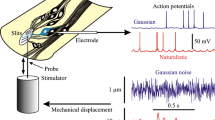Summary
This paper presents a model of the neural coding and discrimination of sensory intensity. The model consists of five stages: (1) the coding of stimulus intensity in peripheral receptors or neurons by a ‘rate’ code. The relevance of comparing different analysis intervals for the response is pointed out; (2) neural processing, according to either ‘labeled-line’ or ‘across-fiber pattern’ theory. In addition, two possible non-linearities in the processing are considered: a threshold mechanism, and ‘contrast enhancement’ by reciprocal inhibition; (3) a neural discriminator, based on signal-detection theory; (4) a memory stage; (5) an effector organ providing a behavioral output. Emphasis is put on stages 2 and 3.
The model produces predictions of the differential threshold, which should be directly testable in a behavioral two-alternative forced-choice paradigm. The model will be applied to gustatory intensity discrimination in rat in a subsequent study (Maes and Erickson 1984). The Discussion pays attention to the relative contributions of peripheral and central “noise” sources. It also compares the present model with Beidler's (1958) approach through just noticeable differences (JND's). The model presented here seems more adequate in providing an understanding of sensory information processing.
Similar content being viewed by others
Abbreviations
- AFP :
-
across fiber pattern
- DA :
-
discrimination acuity
- DT :
-
differential threshold
- JND :
-
just noticeable difference
- LL :
-
labeled line
- NTS :
-
nucleus tractus solitarius
References
Beidler LM (1954) A theory of taste stimulation. J Gen Physiol 38:133–139
Beidler LM (1958) The physiological basis of taste psychophysics. Office of Naval Res Symp Report ACR-30; 1–11
Den Otter CJ (1977) Single sensillum responses in the male mothAdoxophyes orana (F.v.R.) to female sex pheromone components and their geometrical isomers. J Comp Physiol 121:205–222
Dethier VG (1976) The hungry fly. Harvard University Press, Cambridge, Massachusetts
Eijkman E, Vendrik AJH (1963) Detection theory applied to the absolute sensitivity of sensory systems. Biophys J 3:65–78
Ganchrow JR, Erickson RP (1970) Neural correlates of gustatory intensity and quality. J Neurophysiol 33:768–783
Green DM, Swets JA (1966) Signal detection theory and psychophysics. John Wiley Sons, New York
Halpern BP, Nelson LM (1965) Bulbar gustatory responses to anterior and posterior tongue stimulation in the rat. Am J Physiol 209:105–110
Johnson KO (1980a) Sensory discrimination: Decision process. J Neurophysiol 43:1771–1792
Johnson KO (1980b) Sensory discrimination: Neural processes preceding discrimination decision. J Neurophysiol 43:1793–1815
Maes FW (1980) Neural coding of salt taste quality in blowfly labellar taste organ. In: Van der Starre H (ed) Olfaction and taste, vol 7. IRL Press Ltd, London, pp 123–126
Maes FW, Bijpost SCA (1979) Classical conditioning reveals discrimination of salt taste quality in the blowflyCalliphora vicina. J Comp Physiol 133:53–62
Maes FW, Erickson RP (1984) Gustatory intensity discrimination in rat NTS: a tool for the evaluation of neural coding theories. J Comp Physiol A 155:271–282
Miller GA (1956) The magical number seven plus or minus two: some limits on our capacity for processing information. Psychol Rev 63:81–97
Norgren R, Pfaffmann C (1975) The pontine taste area in the rat. Brain Res 91:99–117
Ogawa H, Sato M, Yamashita S (1973) Variability in impulse discharges in rat chorda tympani fibers in response to repeated gustatory stimulations. Physiol Behav 11:469–479
O'Mahony M (1972) Salt taste sensitivity: A signal detection approach. Perception 1:459–464
Perkel DH, Bullock TH (1969) Neural coding. Neurosci Res Symp Summ 3:405–527
Scott TR, Perrotto RS (1980) Intensity coding in pontine taste area: Gustatory information is processed similarly throughout rat's brain stem. J Neurophysiol 44:739–750
Slotnick BM (1982) Sodium chloride detection threshold in the rat determined using a simple opérant discrimination task. Physiol Behav 28:707–710
Smith DV (1971) Taste intensity as a function of area and concentration: Differentiation between compounds. J Exp Psychol 87:163–171
Somjen G (1972) Sensory coding in the mammalian nervous system. Appleton-Century-Crofts, New York
Thurstone LL (1927) A law of comparative judgment. Psychol Rev 34:273–286
Uttal WR (1973) The psychobiology of sensory coding. Harper and Row, New York
Von Békésy G (1967) Sensory inhibition. Princeton University Press, Princeton NJ
Wasserman GS (1981)Limulus psychophysics: Increment threshold. Percept Psychophys 29:251–260
Werner G, Mountcastle VB (1965) Neural activity in mechano-receptive cutaneous afferents: Stimulus-response relations, Weber functions, and information transmission. J Neurophysiol 28:359–397
Wong F, Knight BW, Dodge FA (1982) Adapting bump model for ventral photoreceptors ofLimulus. J Gen Physiol 79:1089–1113
Yamamoto T, Kato T, Matsuo R, Araie N, Azuma S, Kawamura Y (1982) Gustatory reaction time under variable stimulus parameters in human adults. Physiol Behav 29:79–84
Author information
Authors and Affiliations
Rights and permissions
About this article
Cite this article
Maes, F.W. A neural coding model for sensory intensity discrimination, to be applied to gustation. J. Comp. Physiol. 155, 263–270 (1984). https://doi.org/10.1007/BF00612643
Accepted:
Issue Date:
DOI: https://doi.org/10.1007/BF00612643




